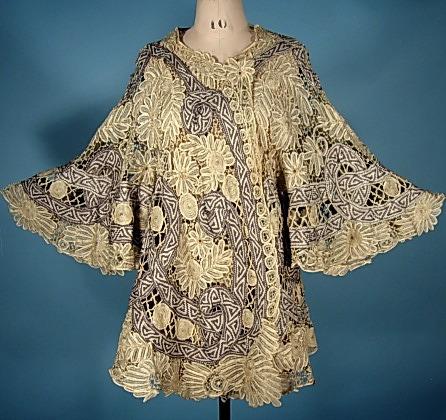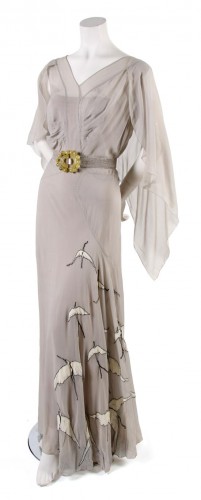One of the drawbacks to becoming relatively popular as a blogger is that suddenly what I say and write actually gets noticed, and affects people. When I started this blog I never imagined I’d have more than a couple dozen readers: I just wanted to document my costumes.
Then, gradually, more and more people started reading, and now I meet all sorts of people in real life who say “Oh, I read your blog”, and I thought “Eeek!” People now have an impression of me without ever meeting me, and (very occasionally) quote my research and opinions.
My first reaction to this was to feel I couldn’t write anything controversial, because I hate arguments and controversy. Lately though I’m beginning to feel that I have an obligation to say what I believe in, and write what matters to me. I’ve done it a bit in the past, with my post on ‘real women’ and ‘universally flattering’ looks (that aren’t), and the sky didn’t fall in, and I didn’t get too many virulent comments (oddly, my post on sewing with acrylic, which I thought was quite innocuous, resulted in far more angry emails), and most of you actually agreed with me and thanked me for saying what I was saying. And if I lost some readers, that’s OK. I’d rather have the ones that will at least consider my opinion, even if they don’t agree with me (and of course the ones that do agree with me are also awesome!).
So here is something that I’ve struggled with for a long time, and have been attacked for even hinting at in some circles in Wellington, but have finally decided is too important not to say.
I don’t like burlesque.
In fact, I don’t just not like burlesque, I think burlesque is just stripping with better clothes, and that it is horribly detrimental to the ongoing struggle to achieve true gender equality and justice, and to women’s status as a whole.
Before those of you who are burlesque fans start telling me I am wrong, and that I don’t really understand what burlesque is, I think that you should know that my initial introduction to it was quite positive. I watched a girl who had discovered burlesque go from being quite insecure to quite self confident, and I thought “that’s awesome”. And friends who taught and took it told me all about how it was about developing poise, and subverting the usual ideas of feminine objectification, and I thought “those are excellent things.” And, for as much as I knew of it or was exposed to it, I approved of it and thought it was quite worthy.
Unfortunately, the more I saw of burlesque, the less I was able to find these supposed ideals. Instead, I saw the same old objectification of women: the same old treating women purely as items to be looked at.
The burlesque poses and performances were all the same tropes that you see in Victorian peep-shows and 1950s pin-ups (and, from what I gather, modern lightly-clothed magazines). You have your choice of A) the child-like female who is surprised and astonished to be caught with her skirt blowing up to reveal her knickers (the big-eyed “Oh!” face), B) the confident, sexually aggressive woman (usually in black or animal print, sometimes with a whip) who enjoys taking off her bits for the sake of the audience, or C) the girl who find that playing with other girls is just a bit more fun than she though (but only if men are looking on).
Yes, the audience at many burlesque shows is mainly women, but I don’t think that women objectifying other women is all that much better (if at all) than men objectifying women.
Finally, after a long and difficult struggle with myself (I have friends who I respect in all other matters who are very involved with burlesque). I decided that no matter how it was phrased, and how it was dressed up, anything that was primarily about presenting women primarily as objects to be viewed, and to be judged based on their physical attractiveness (even if it allows for a broader range of physical attractiveness) isn’t OK with me.
So I have to say it. I don’t like burlesque. Yes, there are the occasional burlesque routines that are witty and clever and not about objectification and do subvert the usual stripping paradigms. These, however, definitely seem to be more the exception than the rule. I do acknowledge that there are women who have gained a lot of confidence, and to be comfortable with their own body, because of burlesque, and that’s great. However, I maintain that there are other ways these women could have gained this confidence, and that on balance, burlesque is hurting women more than it is helping them.
I am appalled that the world is holding up Dita von Teese as an inspiration to girls, and I certainly don’t think she should be a role model. Sure, she overcame a drug addiction and went on to have a ‘productive’ life, but plenty of other women have overcome drug addictions and gone on to really help the world. Sure, she’s built up a successful life, but if you want a female business model, there are many better choices. When it comes down to it, there is only one big thing that I respect the grande dame of burlesque for, and that is for saying that when it comes down to it, she’s just a stripper. I respect honesty.
On the same hand, because I dislike burlesque because I see it as objectifying women, and reducing us to primarily physical roles, where we are judged on looks, I dislike extreme modestly, like the all-enveloping ‘wholesome’ swimsuits that Elise posted a few weeks back. It may be on the opposite end of the spectrum, but it also reduces women to physical objects, with bodies so tempting they must be covered up lest they lead men astray. They are two sides of the same coin, and neither gives women space to be interacted with as people, not just viewed as objects of desire.
As a woman, as a person, I want to be judged as a person, for my personality and my thoughts. I may be a woman who thinks a lot about bodies and clothes, but I want the people who I interact with to realise that I really am thinking about bodies and clothes (just as I might think about cars, were I a mechanic, or policy, if I worked for the government, or programming, if I were a computer scientist), not just being a body with clothes that should be shown off or hidden, at the whim of the current (usually male) powers that be.
So, as an occasional seamstress and corseteer for hire, and the someone with friends who do burlesque, what am I actually going to do about it as a person?
Well, I’m not going to take any burlesque commissions, because that involved me in it, but in the end, I do think morality has to be a personal choice. I’ve chosen not to drink, and to be vegetarian, but those were my personal choices. I don’t sit at dinner with friends who eat meat and have a glass of wine and condemn them for their choices (but I also won’t buy their alcohol). I chose to be chaste until marriage, but I don’t look at my unmarried friends and their partners and think “you slut” – that’s not what morality is about.
I firmly believe people have to choose what their own actions are, and what actions they are happy with, and as long as their actions don’t overly impact on others who can’t agree to it, that’s fine (sleeping with whoever you choose, as long as they can reasonably consent = fine, your choice, private. Sleeping with someone who can’t properly consent because of age, state of inebriation, species = not fine. Drinking a reasonable amount = fine, your choice, private. Drinking and driving, or drinking enough that you loose control and might attack someone = not fine).
So I choose not to be involved with or condone burlesque, but if you do, that’s your choice. However, I do need to speak up. I just can’t nod and smile and pretend to be OK with it any longer, because in the end, I think it is making it that much harder for me, and for all women, to be judged primarily as a person, for their intellect and personality, rather than as an ornament or a temptation, to be enjoyed or avoided for my body and looks. If you need to stop reading this blog, or move on from me as a friend, because of this, that’s OK.
But, if like me, you felt that you couldn’t really say “Hey, I don’t think this is so great after all”, please feel its OK to do so.












